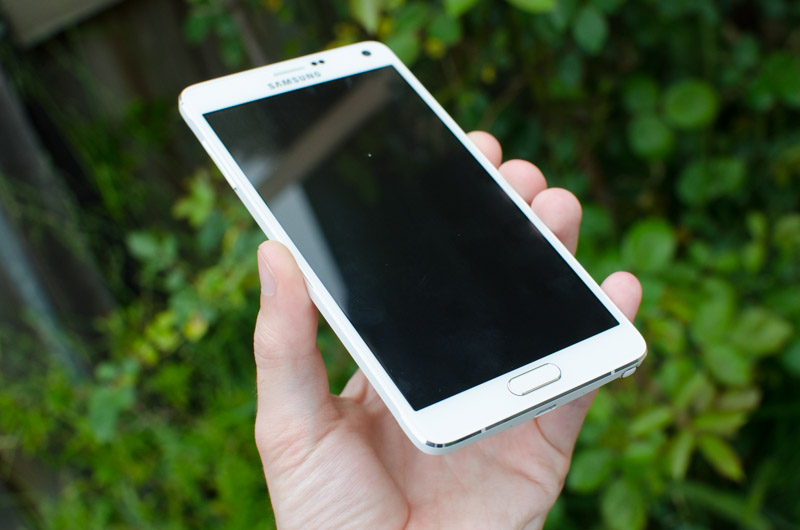Hardware Overview
Like the past few generations of Samsung flagships, there are two main models available, one with Qualcomm Snapdragon internals, and another with Samsung Exynos inside. For several years now the Snapdragon model has been the one most commonly sold, highlighting Qualcomm's dominance in the SoC space over this period. However, Samsung continues to sell an Exynos model not just to show what their tech is capable of, but also to provide a cheaper option for some markets and to gather feedback on the performance of their own silicon.
With the Galaxy S5, for example, Samsung marketed a Snapdragon 801-powered model with LTE for most developed markets, while the Exynos 5422 model (that lacked LTE) was available in select regions. In my performance review of the Galaxy S5 I discovered that although the Snapdragon 801 model was faster and supported LTE, the Exynos variant was $50 cheaper and still held its own despite somewhat weaker hardware.
When it comes to the Galaxy Note 4, both models have been upgraded significantly from a hardware perspective relative to the Galaxy S5, the Exynos model especially. I still expect the Qualcomm model to be more prevalent in the market though, as the Qualcomm brand is well established in the minds of people who read in-store spec sheets.
The Qualcomm variant of the Galaxy Note 4 packs a Snapdragon 805 APQ8084 SoC, which is new to the TechSpot test bed. As it's an APQ designated part, the chip lacks an in-built LTE modem; however, Samsung has indicated that this model supports Category 6 LTE (300 Mbps down, 50 Mbps up through 2x20 MHz carrier aggregation), suggesting it's utilizing Qualcomm's fourth-generation Gobi MDM9x35 modem.

Aside from needing a dedicated modem, the APQ8084 is a beastly chip. It's still built on a 28nm HPm process and uses an ARMv7-A instruction set, but has received updates in almost every area compared to the Snapdragon 800/801. For starters, we're looking at four Krait 450 cores clocked up to 2.7 GHz. Krait 450 is a moderate upgrade on the Krait 400, providing slightly more speed per clock. This means we can expect a jump in performance larger than the relative increase in clock speed over the cores.
As for the GPU, Qualcomm is packing in the Adreno 420, which now supports OpenGL ES 3.1 and Direct3D 11.2. Clocked at up to 600 MHz, Qualcomm is reporting that the Adreno 420 delivers 40% better performance and a 20% reduction in power compared to the Snapdragon 800's Adreno 330, which is impressive.
On the memory side, we're looking at a pretty significant jump in theoretical bandwidth compared to the Snapdragon 801. The 801 provided 14.9 GB/s of bandwidth through a 32-bit dual-channel LPDDR3 controller clocked at 933 MHz; in the 805, this has been upgraded to quad-channel at 800 MHz. As such, the Snapdragon 805 is capable of a maximum 25.6 GB/s of throughput when talking to the 3 GB of on-board RAM in the Galaxy Note 4.

The improvements don't stop there: the Snapdragon 805 also supports HEVC (H.265) decoding on hardware for the first time. Not only that, the image signal processor (ISP) has been upgraded to support 1.2 gigapixels of throughput per second, good enough for 4K/30 video capture or 1080p/120. The dual-ISP design supports up to 55-megapixel cameras.
On the connectivity front, the Snapdragon 805 provides dual-band Wi-Fi 802.11a/b/g/n/ac with MU-MIMO, Bluetooth 4.1 (yes, not 4.0 anymore), and IZAT Gen8B A-GPS+GLONASS.
And now that you've digested all that information about the Snapdragon 805, there's another model to talk about. Again, the Note 4 is a high-end device, so it requires the best that Samsung has to offer. Enter the new Exynos 7 Octa SoC that Samsung detailed shortly after the release of the Note 4. The chip falls into a new line of SoCs from Samsung, and it's the second 20nm HKMG chip from the company (after the Exynos 5 Octa 5430 in some Galaxy Alpha models).
Interestingly, the Exynos 7 Octa 5433 is the first chip out of Samsung to use ARM's 64-bit capable ARMv8-A architecture. Unfortunately, as Android 4.4.4 doesn't support 64-bit architectures, this SoC runs in 32-bit mode for the Galaxy Note 4. It's possible that 64-bit support will be added by the time the Note 4 receives an update to Android 5.0 Lollipop, though I wouldn't count on it. That said, actually delivering an ARMv8 chip at this stage is quite a significant achievement, even if 64-bit support isn't enabled, so I'll take what I can get.
Before I dig too far into the actual specs of the 5433 (or what I can find on it), moving to 20nm is an important step in itself. Samsung is now a node ahead of Qualcomm in actual shipping silicon (though their 20nm parts aren't too far away), and should have an edge in power consumption and/or performance if they play their cards right, at least compared to the 28nm Snapdragon 805.
Like past Exynos products, the Exynos 7 Octa 5433 is a big.LITTLE part, meaning it uses a combination of "little" low power cores in tandem with "big" performance-oriented cores. It also supports heterogeneous multi-processing with global task scheduling, allowing the small and big cores to operate simultaneously. Theoretically this should provide the perfect mix of performance and power efficiency, although for the past few years I've had Qualcomm ahead on both fronts. This may change with the 5433, though.
The big update to this Exynos 7 Octa we're seeing in the Galaxy Note 4 is the use of both ARM Cortex-A57 and Cortex-A53 CPU cores. The Exynos 5433 uses four A57s clocked at 1.9 GHz and four A53s clocked at 1.3 GHz, making the SoC an octa-core part. More important than the core count, though, is the architecture behind these new cores, which has been upgraded significantly over the A15/A7 cores of the past.

The Cortex-A57 is ARM's current flagship CPU core, supporting 64-bit applications and packing improved performance compared to the Cortex-A15. ARM states that, at the same clock speed, an A57 core will be around 20-30% faster than an A15 under 32-bit workloads (it'll be even faster in 64-bit mode, but that's not relevant for the Galaxy Note 4 at this stage). These cores are used in the Exynos 7 Octa for high-performance tasks like gaming and image manipulation.
The Cortex-A53 is paired with the A57 as it's more power efficient, though it's still should deliver improved performance compared to the A7 it replaces. Like the A57, it supports 64-bit applications, and ARM claims it performs around the same level as the Cortex-A9, but with a smaller die and better energy efficiency. This means that the A53 today, complementing the more powerful A57, will be able to deliver a 2012 flagship level of performance as merely a low-power core.
Samsung claims their new Exynos 7 Octa's CPU is 57% faster than the CPU in their Exynos 5 Octa, though they weren't exactly specific about which Exynos 5 Octa they were comparing their latest SoC to. I also suspect that Samsung's figures factor in the CPU running in 64-bit mode, which is not supported on the Note 4 (at least at this stage).

The GPU used in the Exynos 5433 is also from ARM, this time the Mali-T760 clocked at 700 MHz. Like the jump to Cortex-A5x cores, we're seeing a generational jump in GPU as well. Although this GPU still uses ARM's Midgard architecture, it's now in its third generation, which (like most upgrades in the mobile space), promises better performance and energy efficiency compared to its predecessors.
I'm not completely confident on the specifications of the exact Mali-T760 variant used in the Exynos 5433, though I expect it's the eight-core model. This would give it, at least on paper, performance above what the Adreno 330 provides in the Snapdragon 801. How the GPU compares to the Adreno 420 in the Snapdragon 805 will be quite interesting, as in the past Qualcomm has had a significant advantage in this space. Samsung themselves claim a 76% performance improvement over the Mali-T628MP6.

As for the memory controller, the Exynos 5433 uses a dual-channel 32-bit LPDDR3 controller clocked at 825 MHz, providing 13.2 GB/s of bandwidth. This is around Snapdragon 800 levels of throughput, so it's a bit behind the Snapdragon 805. How restrictive this will be remains to be seen; I'd expect graphics could be an area that the limited bandwidth affects.
Samsung isn't ready to fully integrate a networking solution into the same die as the Exynos SoC, so extra chips are needed to facilitate Wi-Fi, Bluetooth, LTE and other connectivity features. Luckily Samsung has used high-end parts for the Exynos variant of the Note 4, meaning you'll get largely the same features as the Snapdragon model, including LTE (for once) thanks to an Exynos 303 modem.
The Exynos model packs Category 4 LTE (150/50 Mbps), which should suffice for most countries worldwide (though as I mentioned earlier, I still expect the Snapdragon model to be more prevalent). There's also HSPA+, GSM/GPRS/EDGE, Wi-Fi 802.11a/g/b/n/ac, Bluetooth 4.1, and A-GPS+GLONASS.
| Specs | Galaxy Note 4 SM-N910T | Galaxy Note 4 SM-N910U |
| SoC | Snapdragon 805 APQ8084 | Exynos 7 Octa 5433 |
| CPU | 4x Krait 450 @ 2.7 GHz | 4x ARM Cortex-A57 @ 1.9 GHz + 4x ARM Cortex-A53 @ 1.3 GHz |
| GPU | Adreno 420 @ 600 MHz | ARM Mali-T760 @ 700 MHz |
| Memory | 3 GB quad-channel LPDDR3 @ 800 MHz | 3 GB dual-channel LPDDR3 @ 825 MHz |
| Storage | 32 GB internal + microSD | |
| Wi-Fi | 802.11 a/b/g/n/ac | |
| Bluetooth | 4.1 | |
| LTE | Category 6 | Category 4 |
| Other | NFC, Infrared LED, MHL, DLNA, GPS+GLONASS, HSPA+, 2G | |
| Display | 5.7" 1440p Super AMOLED | |
| Battery | 12.4 Wh (3,220 mAh) | |
| Camera | 16 MP 1/2.6" sensor with f/2.2 lens and OIS | |
Both models also have an infrared LED for controlling TVs, and NFC on-board. As far as hardware goes the Snapdragon and Exynos models are the closest I've seen from Samsung in quite some time, and it's especially important to see both now with LTE inside.


